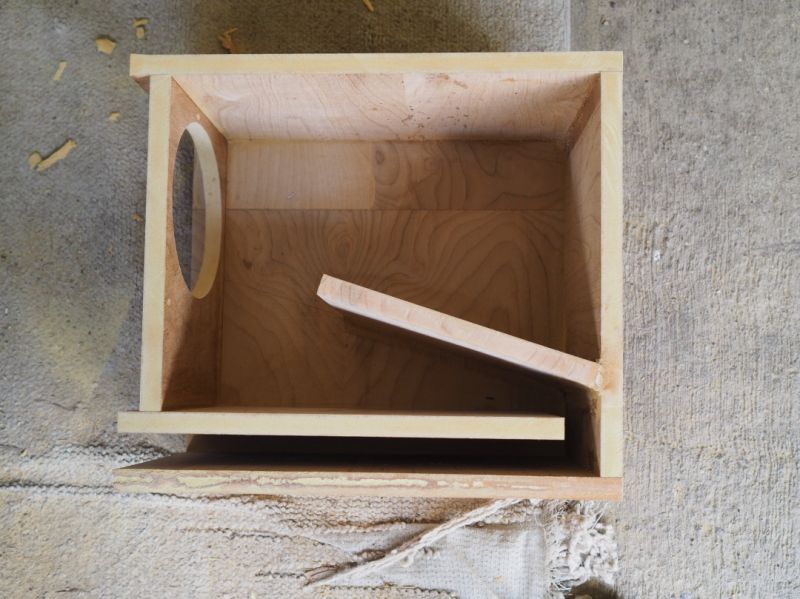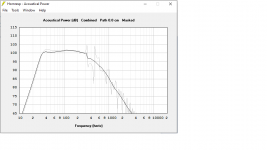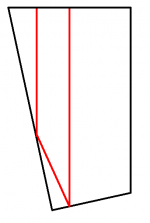It went on to talk about Golden Ratio as applied to both loudspeaker enclosures and listening rooms.
Golden Ratio is not magic. It is an example of applying irrational numbers to box ratios so as to minimize standing waves piling up.
It also has a certain aesthetic that some like.

dave
If the side to side box distance was 24, and the vertical 31, the the vertical standing wave would be 350 hz, getting out of the critical voice smoothness band. Besides in the SP2 whose trapezoidal pinch I was refering to, the vertical dimension is full of a plastic tweeter horn, which probably helps to break up the standing wave in the vertical dimension.The 2 non-parallel walls have to have a considerable angle to signicantly reduce side-to-side standing waves, but you still have 2 pair of parallel sides, in the case of the illustration, the one with the most significant standing wave is the lnest one, top-to-bottom.
The non-parallel sides will help minimise dimensional resonance effects.
To some degree yes, but this box shape also means that the side panels needs to be larger and larger panels usually means structural weakness
What's the frequency range? Are you talking a sub, or a low-mid?
If a sub, a trap box is worthless, completely counterproductive.
For a bass-reflex, you want almost invariably, as much volume vs box size, as you can get...ala a modified cube for the task at hand.
If for 100Hz up, then yes, a trap can definitely help.
Both for the ability to array, and to move/spread around internal resonances etc..
KIT 18sound
it is exclusively the container box made for the woofer (15w700). 140 liters of volume.
because I don't insert the audio speaker and mid-high frequency horn (ND1460 + XR1496c) in the same container box together with the woofer.
Hi Arivel
I didn't have a closer look but isn't the volume of the original building plan smaller than 140 liters ? Anyway - with 140 liters it should be possible to get a nice LF extension.
If you use it purely for home listening I would also use a rectangular box if I were you.
Regards
Charles
I didn't have a closer look but isn't the volume of the original building plan smaller than 140 liters ? Anyway - with 140 liters it should be possible to get a nice LF extension.
If you use it purely for home listening I would also use a rectangular box if I were you.
Regards
Charles
I'm aware of that, but I have a question in relation to the formation of standing waves.Golden Ratio is not magic. It is an example of applying irrational numbers to box ratios so as to minimize standing waves piling up.
To sustain a standing wave requires a continuous input of energy at one exact frequency - a situation that can be maintained by the use of a signal generator.
When it comes to music signals, the input of energy at any one exact frequency tends to be transitory and non-continuous in nature.
To what extent can standing waves in enclosures be sustained by music signals which continually change in frequency?
The resonance has an decay or an hangover just like a church bell that keeping on resonate even after you stop hitting it
Unfortunately, it won't - trust me on this.the vertical dimension is full of a plastic tweeter horn, which probably helps to break up the standing wave in the vertical dimension.
The 2 non-parallel walls have to have a considerable angle to signicantly reduce side-to-side standing waves, but you still have 2 pair of parallel sides, in the case of the illustration, the one with the most significant standing wave is the lnest one, top-to-bottom.
The ideal shape would depend on the goals, could be different on the inside than the outside and will change (at least in scale) depending on the frequency.
Everything is a compromise. The outside edges of your box are not ideal, for instance, wrt diffraction.
dave
A commonly used shape where it does make a difference is when one dimension becomes significantly larger than the other 2 a BR transforms into an ML-TL and has to be modeled and tuned differently.
dave
Dave can you help me understand and hopefully it can add to this posts also.
This is always one of those things that gets me questioning subwoofer design.
like when a bass reflex box has a single board inside and it still remains close to cube shaped and not where one dimension becomes significantly bigger that the other 2 and its called a MLTL not picking on Brian ive been referencing his website and posts for a long time. they are just ones i see and can remember.
for example:

or this :
.jpg)
i think im going to try simulating these both as a BR enclosure and see what i see i hope you can add to this
Thanks Celef. 😎The resonance has an decay or an hangover just like a church bell that keeping on resonate even after you stop hitting it
Vibrational modes will persist in the structure of a bell for some time after their initial excitation.
I can't see that standing waves can persist in the air inside a speaker enclosure after their initial excitation has stopped.
I therefore presume you are referring to enclosure wall resonances.
yes the project was referred to 130 liters but then reading the datasheet I saw that you can get to 140 liters.Hi Arivel
I didn't have a closer look but isn't the volume of the original building plan smaller than 140 liters ? Anyway - with 140 liters it should be possible to get a nice LF extension.
If you use it purely for home listening I would also use a rectangular box if I were you.
Regards
Charles
https://www.lautsprechershop.de/pdf/18s/18sound_15w700.pdf
Thanks Celef. 😎
Vibrational modes will persist in the structure of a bell for some time after their initial excitation.
I can't see that standing waves can persist in the air inside a speaker enclosure after their initial excitation has stopped.
I therefore presume you are referring to enclosure wall resonances.
a cavity can do resonate and have a decay time, i think you can google some waterfall graphs for room acoustic measurements, good luck
Isn't the prolongation of sound in a room caused by multiple reflections i.e. reverberation?a cavity can do resonate and have a decay time,i think you can google some waterfall graphs for room acoustic measurements, good luck
However, a standing wave does have an exponential damping time constant, which I'll now look into more closely - thanks. 😎
Bassreflex boxes with little or no acoustic damping inside rings like hell and should not be used, funny then that so many audiophiles and speaker junkies wants their speakers almost empty
Dave can you help me understand and hopefully it can add to this posts also.
Hello .
the slot must be strictly lateral vertical or can it be placed horizontally under the woofer?.
is this solution also applicable in my case?
To sustain a standing wave requires a continuous input of energy at one exact frequency - a situation that can be maintained by the use of a signal generator.
When it comes to music signals, the input of energy at any one exact frequency tends to be transitory and non-continuous in nature.
To what extent can standing waves in enclosures be sustained by music signals which continually change in frequency?
my emphasis
That is a good question. Much the same rationale i use when considerin gpanel resonance in my boxes, everything can be made to ring, let’s put them where music is unlikely to ever excite them.dave
Thinking about box fill/wall lining, i usually think more in term of keeping time-smeared crap from getting back thru the cone.
dave
The resonance has an decay or an hangover just like a church bell that keeping on resonate even after you stop hitting it
But a bell is designed to ring, and the excitation large and long enuf fto get things going.
If you did not excite the bell with something that does not get it ringing, it makes no noise.
I wonder how it would work if you glued a piece of braced plywood to the bell opening and used the thing as. a sub enclosure i wonder how it would work.
dave
It hasn't yet been show that there is such a problem (in this case). Such walls may make a change, it doesn't automatically improve matters.
True, though like a room it needs a >12 deg taper for 'slap echo' to decay quickly and to take further advantage; do the same with the other two planes.
This can dramatically reduce the need for internal damping assuming its construction pushes the box resonance far enough out of band.
Interesting. Is independent resonance the only way delayed sound can have an effect?
The slap echo treatment has been used in the past to advantage. However on a geometric level and susceptibility to standing waves forming, here is one based on 12 degree walls (one out of each pair).
The slap echo treatment has been used in the past to advantage. However on a geometric level and susceptibility to standing waves forming, here is one based on 12 degree walls (one out of each pair).
Attachments
- Home
- Loudspeakers
- Multi-Way
- shape of the bass reflex box

